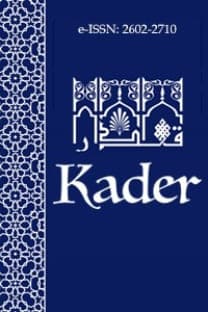Basit ve Bileşik: Kelâmda Cismin Tanımı ve İbn Kemâl’in Tafra Eleştirisi
Kelâmcılar metafizik ilgilerinin bir neticesi olarak erken dönemden itibaren tabiatla ilgilenmeye başladılar ve düalist ve materyalist akımların da etkisiyle âlemin yapısını ve işleyişini izah etmeye çalışan çeşitli teoriler ortaya attılar. Zaman içinde teorik fiziğe dair pek çok konu kelâmın vazgeçilmez bir parçası haline geldi ve temel ilkelerin ispatı yönünde kullanıldı. Böylece kelam kitapları cismin tanımı yanında zaman, mekân, hareket ve mesafe gibi fizik konuları ayrıntılı biçimde içermeye başladı. Bu makalede öncelikle ilk dönemden itibaren kelâmcıların yaptığı cisim tanımları özetlendikten sonra İbn Kemâl’in Türkiye Kütüphanelerinde farklı isimlerle pek çok nüshası bulunan tafra risalesi tanıtılacaktır. Bu risalenin girişinde başlıca cisim tanımlarını sıralayan İbn Kemâl sonra da bilfiil sonlu bölünmeye inanan kelâmcılar ile bilfiil sonsuz bölünmeyi kabul eden Nazzâm’ın görüşlerini mukayese etmektedir. Her iki grubun temel delillerini gerekçeleri ile aktararak eleştiriye açık yönlerini belirtmektedir. İbn Kemâl cisim tanımının zorunlu bir sonucu olarak gördüğü tafra fikrini çeşitli açılardan incelerken Kutbüddîn er-Râzî’nin görüşlerini de gözden geçirmektedir.
Anahtar Kelimeler:
İbn Kemal, Kelam, Osmanlı Düşüncesi, Cismin Tanımı, Atomculuk, Nazzam
Simple and Composite: Definition of Body in Kalām and Ibn Kamāl’s Criticism of Ṭafra
The mutakallimūn, who began to take care of nature as a result of their metaphysical concerns from the early period and with the influence of the dualist and materialist groups, suggested various theories that attempt to explain the structure and functioning of the universe. Over time, many subjects of physics became an indispensable part of Kalām and were used in the proof of the fundamental principles. Thus, in addition to the definition of body (jism), Kalām books began to contain detailed topics such as time, space, movement and distance. After summarizing the definitions of body, which were made by the mutakallimūn, this article will examine the contents of Ibn Kamāl's epistle on ṭafra (leaping), which has many copies with various titles in the Turkish Libraries. In the beginning of the epistle, Ibn Kamāl mentions the descriptions of body suggested by the prominent mutakallimūn, and then, he compares the views of al-Naẓẓām, who believes in the finite division, with atomist mutakallimūn who accept the infinite division. He criticizes the idea of ṭafra with regard to the notion of body in Kalām. After explaining the arguments of both groups with their justifications, he points out the weaknesses of the arguments of each group, as well. In this connection, he revisits the theory of ṭafra , which is, he argues, a mandatory consequence of al-Naẓẓām’s definition of object, as he also reviews the opinions of Quṭb al-Din al-Rāzī in this direction.
Keywords:
Kalām, Ibn Kamāl, al-Naẓẓām, Atomism, Theory of Ṭafra,
___
- İbn Kemal, Risale fi Beyan Tahkik Hakikatü'l-Cisim, Beyazıd Devlet, Veliyyüddin Efendi nu.3235, vr. 51a-53a.
- Eş'ari, Makalatü'l-İslâmiyyin ve ihtilafü'l-musallin, tsh. Hellmut Ritter, Wiesbaden : Franz Steiner Verlag, 1963.
- Osman DEMİR, Kelamda Nedensellik, İlk Dönem kelamcılarında Tabiat ve İnsan, İstanbul: Klasik 2015.
- Başlangıç: 2003
- Yayıncı: Mehmet BULĞEN
Sayıdaki Diğer Makaleler
Hassas Ayar Açıklamaya Muhtaç Mıdır?
Ebu'l-Feth Muzaffer El-Hatîb’in 'Elfâz-ı Küfr' Risalesi
Heidegger'in Sorusu, Descartes'ın Suskunluğu ve Taşköprülüzâde'nin Cevabı
Hükümlülerde Kader ve Kadercilik
Ahmet ALBAYRAK, Beyza AKDÜMBEK ATAN
Mâtûrîdî Kelâm Okulunda İnsan Hürriyeti Problemi
Mâtürîdî’ye Göre Allah’ın Varlığını Aklen Bilmenin İmkânı
Şeytan’ın Saptırmasına İlişkin Kur’an İfadelerinin İrade Hürriyeti Açısından Değerlendirilmesi
